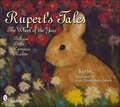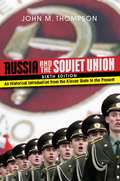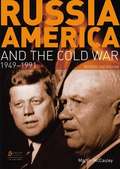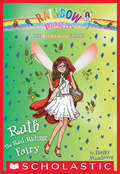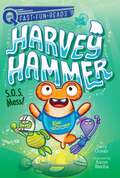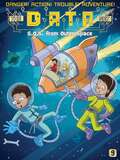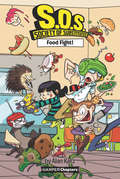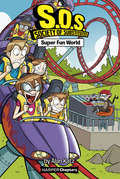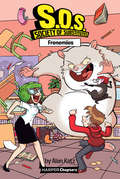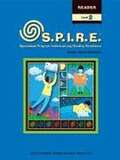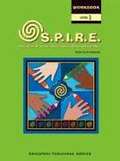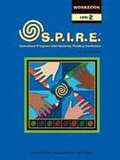- Table View
- List View
Rupert's Tales: Learning Magic
by KyrjaFollow the adventures of Rupert the rabbit as he learns that intentions and imagination are two of the most important ingredients in all things magickal. In “Tools of the Craft,” Rupert meets a family who has come to teach their children about tools they use in crafting magick. “Rupert’s Magickal Imagination” has him watching children practicing using their intentions when one of them wonders what happens if you don’t believe in magick. With two rhyming stories and 23 vibrant illustrations, this book offers an enchanting way to help your child begin a journey to learn about magick. For readers aged 5 to 8.
Rupert's Tales: The Wheel of the Year Beltane, Litha, Lammas, and Mabon
by KyrjaA groundbreaking story that collects, commemorates, and illuminates traditional, sacred Pagan practices and beliefs in a fresh, contemporary, and whimsical style. Join Rupert the rabbit on his adventures as he sets out to discover how and why people leave their homes to celebrate seasonal holidays in the forest where he lives. As Rupert's journey unfolds throughout the seasons, he meets owls, fairies, and old friends who teach him about the Wheel of the Year. Beautifully illustrated, this book is an excellent starting point for young children being raised within the loose structure of the various Pagan traditions. You don't have to be Pagan to be enchanted by Rupert and the magick found in his tales.
Russia and the Soviet Union: A Historical Introduction from the Kievan State to the Present
by John M. ThompsonUnlike most Soviet-centered histories, A Vision Unfulfilled begins with a chapter summarizing late nineteenth-century Russian history, allowing instructors to begin their course with 1894, 1905, 1914, or 1917. The book also gives fuller attention to the history of the non-Russian populations in the tsarist and Soviet empires than other texts of its kind.
Russia, America and the Cold War, 1949-1991
by Martin MccauleyFollowing on from McCauley's bestselling Origins of the Cold War, this book looks at the years from 1949 to 1991. The Cold War is increasingly offered as a second/third year option as history courses become more focused on the twentieth century Also useful for students of politics and international relations This is a completely to date survey of the subject Includes chronology, list of treaties and summits between the superpowers and who's who.
Ruth the Red Riding Hood Fairy: A Rainbow Magic Book (Storybook Fairies #4)
by Daisy MeadowsOnce upon a time in Fairyland. . . . Jack Frost is up to his old tricks again. He has sent his goblins to steal the Storybook Fairies' magic objects -- and now readers' favorite stories are all mixed up. Rachel and Kirsty only have one more magic object left to find. After they return Ruth's basket, their favorite stories will be back to normal!
S.O.S. Mess!: A QUIX Book (Harvey Hammer #3)
by Davy OceanIn the third book of a Shark School series spin-off, young hammerhead shark Harvey Hammer saves his friend from being turtle-napped!Harvey asks his best buddy Flash the turtle to join him on a family vacation to the Safari Park to see leggy-airbreathers (humans). But when Harvey and Flash get bored and wander off too close to the rock pools, Flash is turtle-napped by the leggy-airbreathers! Will Harvey be able to save his pal, or is Flash destined to become someone&’s pet—or worse, a bowl of soup?
S.O.S. from Outer Space (The DATA Set #9)
by Ada HopperIn the ninth DATA Set adventure, the kids blast off into outer space!When Laura hears a strange but familiar buzzing coming from her radio, she instantly knows who&’s trying to get in touch. It&’s none other than Fave, the DATA Set&’s alien friend who crashed down on Earth! The kids excitedly decode the message but learn that Fave is in trouble! Join the kids as they suit up and blast off into the galaxy on a mission to help an old friend. With easy-to-read language and illustrations on almost every page, the DATA Set chapter books are perfect for emerging readers.
S.O.S.: Society of Substitutes #1: The Great Escape (HarperChapters)
by Alan KatzIf there’s a problem in school, there’s no substitute for the world-saving substitute teachers of the S.O.S.! This is the first book of this hilarious, highly illustrated early chapter book series. When Milton Worthy learns his classroom’s pet ferret is the evil mastermind behind a dastardly plot for world domination, it’s more than just about any kid could handle. But then not every kid is the son of a member of the super-secret, super-awesome Society of Substitutes!Now it’s up to Milton and his substitute teacher mom to save Beacher Elementary School before time runs out. HarperChapters build confident readers one chapter at a time! With short, fast-paced books, art on every page, and milestone markers at the end of every chapter, they're the perfect next step for fans of I Can Read!
S.O.S.: Society of Substitutes #2: The Zoo Switcheroo (HarperChapters)
by Alan KatzIf there’s a problem in school, there’s no substitute for the world-saving substitute teachers of the S.O.S.! This is the second book of this hilarious, highly illustrated early chapter book series.Oh no! Noah—part time classroom pet, full-time evil mastermind—has his paws set on setting free all the animals at the city zoo.Good thing that when there’s a problem, there’s no substitute for the super substitute teachers of the S.O.S.! HarperChapters build confident readers one chapter at a time! With short, fast-paced books, art on every page, and milestone markers at the end of every chapter, they're the perfect next step for fans of I Can Read!
S.O.S.: Society of Substitutes #3: Food Fight! (HarperChapters)
by Alan KatzIf there’s a problem in school, there’s no substitute for the world-saving substitute teachers of the S.O.S.! This is the third book of this hilarious, highly illustrated early chapter book series. Oh, no! Noah, the classroom’s evil pet ferret, has stolen everyone’s lunch—and worse yet, he’s done it on a day when Milton’s mom, the class’s go-to super-sub, is off on another assignment.Will Milton be able to foil Noah’s most fiendish plot yet or will they lose their lunches for good in the gooiest, stickiest, biggest food fight ever? HarperChapters build confident readers one chapter at a time! With short, fast-paced books, art on every page, and milestone markers at the end of every chapter, they're the perfect next step for fans of I Can Read!
S.O.S.: Society of Substitutes #4: Super Fun World (HarperChapters)
by Alan KatzIf there’s a problem in school, there’s no substitute for the world-saving substitute teachers of the S.O.S.! This is the fourth book of this hilarious, highly illustrated early chapter book series.It’s Spring Break! Milton Worthy and his family are off on a vacation to Super Fun World. It’s a week filled with roller coasters, rides, and fried food—and no super-sub missions for seven whole days.Everything is going according to plan until Milton gets stuck looking after Noah—part-time classroom pet, full-time evil mastermind—who has an entirely different kind of getaway in mind.Will Milton be able to figure out Noah’s latest plot for world domination before it ruins his family’s fun time?HarperChapters build confident readers one chapter at a time! With short, fast-paced books, art on every page, and milestone markers at the end of every chapter, they're the perfect next step for fans of I Can Read!
S.O.S.: Society of Substitutes #5: Frenemies (HarperChapters)
by Alan KatzIf there’s a problem in school, there’s no substitute for the world-saving substitute teachers of the S.O.S.! This is the fifth book of this hilarious, highly illustrated early chapter book series.Keep your friends close and your enemies closer! When Snowball, the puffball hamster in Ms. Kim’s classroom, accidentally sips the teacher’s leftover protein shake, she transforms into a monster like Beacher Elementary School has never known before. It’s all hands on deck to stop Snowball before it’s too late. And to do that, Milton Worthy is going to do have to team up with Noah, the part-time classroom ferret, full-time evil mastermind! Will Milton and Noah be able to work together in time to stop Snowball and save the world?HarperChapters build confident readers one chapter at a time! With short, fast-paced books, art on every page, and milestone markers at the end of every chapter, they're the perfect next step for fans of I Can Read!
S.P.I.R.E. Blackline Masters for Instruction and Assessment, Level 1
by Sheila Clark-EdmandsNIMAC-sourced textbook
S.P.I.R.E. Blackline Masters for Instruction and Assessment, Level 2
by Sheila Clark-EdmandsNIMAC-sourced textbook
S.P.I.R.E. Blackline Masters for Instruction and Assessment, Level 3
by Sheila Clark-EdmandsNIMAC-sourced textbook
S.P.I.R.E. Blackline Masters for Instruction and Assessment, Level 4
by Sheila Clark-EdmandsNIMAC-sourced textbook
S.P.I.R.E. Blackline Masters for Instruction and Assessment, Level 5
by Sheila Clark-EdmandsNIMAC-sourced textbook
S.P.I.R.E. Blackline Masters for Instruction and Assessment, Level 6
by Sheila Clark-EdmandsNIMAC-sourced textbook
S.P.I.R.E. Level 5 (Third Edition)
by Sheila Clark-EdmandsThis S.P.I.R.E.® Level 3 (spire) decodable reader is perfect for early readers and those who need practice reading simple books with basic phonics concepts. This book includes words with suffix -ed (melted, smelled, winked).
S.P.I.R.E. Workbook Level 1
by Sheila Clark-EdmandsA multisensory reading system for struggling readers. Lessons balance visual, auditory, and kinesthetic modalities to improve memory and learning. Features include more decodable text than any other program.
S.P.I.R.E. Workbook Level 2
by Sheila Clark-EdmandsA multisensory reading system for struggling readers. Lessons balance visual, auditory, and kinesthetic modalities to improve memory and learning. Features include more decodable text than any other program.

